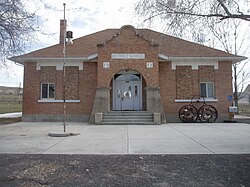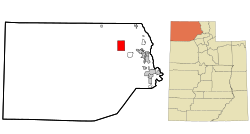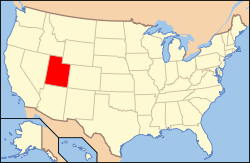Howellis a town located in theBlue Creek Valleyin northeastBox Elder County,Utah,United States.[3][1]The population was 245 at the2010 census.
Howell | |
|---|---|
 The old schoolhouse in Howell, March 2009 | |
 Location of Howell withinBox Elder Countyand theState of Utah. | |
 Location of Utah in the United States | |
| Coordinates:41°46′23″N112°27′35″W/ 41.77306°N 112.45972°W | |
| Country | United States |
| State | Utah |
| County | Box Elder |
| Settled | 1910 |
| Incorporated | 1941 |
| Named for | Joseph Howell[1]: 194 |
| Area | |
• Total | 35.47 sq mi (91.87 km2) |
| • Land | 35.27 sq mi (91.36 km2) |
| • Water | 0.20 sq mi (0.51 km2) |
| Elevation | 4,561 ft (1,390 m) |
| Population (2010) | |
• Total | 245 |
• Estimate (2019)[4] | 254 |
| • Density | 7.20/sq mi (2.78/km2) |
| Time zone | UTC-7(Mountain (MST)) |
| • Summer (DST) | UTC-6(MDT) |
| ZIP code | 84316 |
| Area code | 435 |
| FIPS code | 49-36620[5] |
| GNISfeature ID | 2412774[3] |
Geography
editAccording to theUnited States Census Bureau,the town has a total area of 35.6 square miles (92 km2), of which 35.4 square miles (92 km2) is land and 0.2 square miles (0.52 km2) (0.56%) is water.
Climate
editThere is a weather station nearby atThiokolAirport. Thiokol Airport/Howell's climate borders between beingsemi-aridandhumid continental climate(KöppenBSk/Dfb), characterized by cold winters, warm-to-hot summers, and highdiurnal temperature variationthroughout the year.
| Climate data for Thiokol Propulsion F S, Utah, 1991–2020 normals, 1962-2020 extremes: 4600ft (1402m) | |||||||||||||
|---|---|---|---|---|---|---|---|---|---|---|---|---|---|
| Month | Jan | Feb | Mar | Apr | May | Jun | Jul | Aug | Sep | Oct | Nov | Dec | Year |
| Record high °F (°C) | 56 (13) |
65 (18) |
74 (23) |
85 (29) |
96 (36) |
103 (39) |
108 (42) |
107 (42) |
98 (37) |
88 (31) |
78 (26) |
60 (16) |
108 (42) |
| Mean maximum °F (°C) | 44.6 (7.0) |
53.5 (11.9) |
67.0 (19.4) |
77.5 (25.3) |
85.5 (29.7) |
95.4 (35.2) |
100.9 (38.3) |
99.6 (37.6) |
93.4 (34.1) |
81.1 (27.3) |
61.5 (16.4) |
48.2 (9.0) |
101.9 (38.8) |
| Mean daily maximum °F (°C) | 29.8 (−1.2) |
36.7 (2.6) |
48.4 (9.1) |
56.0 (13.3) |
66.8 (19.3) |
81.1 (27.3) |
89.6 (32.0) |
89.1 (31.7) |
77.0 (25.0) |
60.4 (15.8) |
44.4 (6.9) |
34.3 (1.3) |
59.5 (15.3) |
| Daily mean °F (°C) | 21.2 (−6.0) |
24.9 (−3.9) |
36.1 (2.3) |
43.1 (6.2) |
53.1 (11.7) |
64.1 (17.8) |
71.9 (22.2) |
70.8 (21.6) |
59.5 (15.3) |
44.7 (7.1) |
32.8 (0.4) |
23.1 (−4.9) |
45.4 (7.5) |
| Mean daily minimum °F (°C) | 12.5 (−10.8) |
13.2 (−10.4) |
23.7 (−4.6) |
30.1 (−1.1) |
39.3 (4.1) |
47.0 (8.3) |
54.2 (12.3) |
52.4 (11.3) |
42.0 (5.6) |
28.9 (−1.7) |
21.2 (−6.0) |
12.0 (−11.1) |
31.4 (−0.3) |
| Mean minimum °F (°C) | −1.7 (−18.7) |
−0.5 (−18.1) |
11.0 (−11.7) |
20.3 (−6.5) |
26.9 (−2.8) |
35.3 (1.8) |
45.2 (7.3) |
42.6 (5.9) |
30.1 (−1.1) |
18.0 (−7.8) |
6.3 (−14.3) |
−2.8 (−19.3) |
−8.1 (−22.3) |
| Record low °F (°C) | −28 (−33) |
−29 (−34) |
−5 (−21) |
10 (−12) |
15 (−9) |
29 (−2) |
35 (2) |
30 (−1) |
20 (−7) |
10 (−12) |
−17 (−27) |
−27 (−33) |
−29 (−34) |
| Averageprecipitationinches (mm) | 1.42 (36) |
0.98 (25) |
1.24 (31) |
1.12 (28) |
1.84 (47) |
1.09 (28) |
0.60 (15) |
0.82 (21) |
0.98 (25) |
1.13 (29) |
0.72 (18) |
1.47 (37) |
13.41 (340) |
| Average snowfall inches (cm) | 5.2 (13) |
4.5 (11) |
0.7 (1.8) |
0.2 (0.51) |
0.0 (0.0) |
0.0 (0.0) |
0.0 (0.0) |
0.0 (0.0) |
0.0 (0.0) |
0.1 (0.25) |
2.6 (6.6) |
7.0 (18) |
20.3 (51.16) |
| Source 1: NOAA[6] | |||||||||||||
| Source 2: XMACIS2 (1982-2010 snowfall, records & monthly max/mins)[7] | |||||||||||||
Demographics
edit| Census | Pop. | Note | %± |
|---|---|---|---|
| 1920 | 302 | — | |
| 1930 | 246 | −18.5% | |
| 1940 | 281 | 14.2% | |
| 1950 | 176 | −37.4% | |
| 1960 | 188 | 6.8% | |
| 1970 | 146 | −22.3% | |
| 1980 | 176 | 20.5% | |
| 1990 | 237 | 34.7% | |
| 2000 | 221 | −6.8% | |
| 2010 | 245 | 10.9% | |
| 2019 (est.) | 254 | [4] | 3.7% |
| U.S. Decennial Census[8] | |||
As of thecensus[5]of 2000, there were 221 people, 68 households, and 55 families residing in the town. Thepopulation densitywas 6.2 people per square mile (2.4/km2). There were 75 housing units at an average density of 2.1 per square mile (0.8/km2). The racial makeup of the town was 99.10%White,0.45%African Americanand 0.45%Native American.
There were 68 households, out of which 41.2% had children under the age of 18 living with them, 75.0% weremarried couplesliving together, 4.4% had a female householder with no husband present, and 19.1% were non-families. 19.1% of all households were made up of individuals, and 4.4% had someone living alone who was 65 years of age or older. The average household size was 3.25 and the average family size was 3.76.
In the town, the population was spread out, with 36.2% under the age of 18, 12.2% from 18 to 24, 20.8% from 25 to 44, 22.6% from 45 to 64, and 8.1% who were 65 years of age or older. The median age was 26 years. For every 100 females, there were 130.2 males. For every 100 females age 18 and over, there were 101.4 males.
The median income for a household in the town was $40,750, and the median income for a family was $42,250. Males had a median income of $39,861 versus $12,292 for females. Theper capita incomefor the town was $16,510. About 7.3% of families and 7.6% of the population were below thepoverty line,including 12.6% of those under the age of eighteen and 17.6% of those 65 or over.
History
editHowell lies in theBlue Creek Valleythat stretches north-south between four mountain ranges,Promontory Mountains,south,North Promontory Mountains,west,West Hills,northeast, and Blue Spring Hills, southeast. The northeastGreat Salt Lakelies to the south of Howell, and north of Howell findsInterstate 84,roughly the area known to locals asBlue Creek.NomadicShoshoneIndians used the area to travel between the Great Salt Lake and areas to the north.
Charles Crocker,a California developer and business man oversaw development of theFirst transcontinental railroad,which passed throughPromontory,about 10 miles (16 km) south of Howell. TheGolden Spikewas driven near Promontory (at Lampo) in 1869. Crocker formed thePromontory Land and Livestock Companyin this time period, which had land holdings that stretched from the Great Salt Lake north to Idaho, and west to Nevada. The area was used for cattle ranching, with headquarters in Promontory, Howell, and the Dilly Ranch. The company disbanded in 1909.
In 1909 the newly createdPromontory-Curlew Land Companypurchased the Promontory Land and Livestock Company's Utah and Idaho land holdings. Howell is named after Utah CongressmanJoseph Howellwho was involved with the Promontory-Curlew Land Company.
In 1910 Nephi Nessen purchased 1,000 acres (4.0 km2) from the Promontory-Curlew Land Company, and established the first private and permanent residence in Howell. Nessen was born inLogan, Utahin 1867, the son ofDanishimmigrants and converts tothe Church of Jesus Christ of Latter-day Saintswho crossed the plains from the east as part of aHandcart company.Other settler families included Andersen, Baxter, Cravens, Gunnell, Bailey, Carlsen, Douglas, Fonnesbeck, Rock, Wood, Allen, Barber, and Maughn.
The Bar M Ranch was headquartered near what is now the town center. A school was opened in 1910 in a Bar M Ranch building. In 1911, a new school was opened (pictured above), which has now been converted into a community center. In 1980, a modern school was built forkindergartenthrough third grades, but closed in 2008.
In 1904, the Blue Creek Reservoir was built on Blue Creek, 1 mile (1.6 km) northwest of Howell.[9]However, the reservoir is now located almost entirely within thetown limits[10]
Transportation
editWhileI-84only passes through the northeastern corner of the town,SR-83heads south from the interstate to pass through the town (and continues on toCorinne).[10]
See also
editReferences
edit- ^abVan Cott, John W. (1990).Utah Place Names: A Comprehensive Guide to the Origins of Geographic Names: A Compilation.Salt Lake City:University of Utah Press.p. 194.ISBN978-0-87480-345-7.OCLC797284427.
- ^"2019 U.S. Gazetteer Files".United States Census Bureau.RetrievedAugust 7,2020.
- ^abcU.S. Geological Survey Geographic Names Information System: Howell, Utah
- ^ab"Population and Housing Unit Estimates".United States Census Bureau. May 24, 2020.RetrievedMay 27,2020.
- ^ab"U.S. Census website".census.gov.United States Census Bureau.RetrievedJanuary 31,2008.
- ^ "Thiokol Propulsion F S, Utah 1991-2020 Monthly Normals".RetrievedNovember 19,2023.
- ^ "xmACIS".National Oceanic and Atmospheric Administration.RetrievedNovember 19,2023.
- ^"Census of Population and Housing".census.gov.RetrievedJune 4,2015.
- ^Van Cott, John W. (1990).Utah Place Names: A Comprehensive Guide to the Origins of Geographic Names: A Compilation.Salt Lake City:University of Utah Press.p. 41.ISBN978-0-87480-345-7.OCLC797284427.RetrievedMarch 20,2018.
- ^ab"Howell, Utah 84316"(Map).Google Maps.RetrievedDecember 26,2016.
External links
edit- Howell - archived page on Box Elder County website(viaweb.archive.org)
- Howell historyArchivedMay 10, 2017, at theWayback Machine(on Box Elder County website)